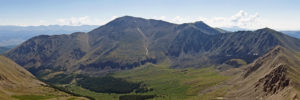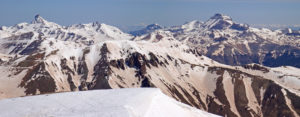The mountaineering frontier of the Western part of the United States is considered a highly-desired destination for hikers. Colorado’s mountainous range boasts a dramatic terrain that is home to numerous fourteeners, mountain peaks with an elevation of at least 14,000.
While the Colorado Geological Survey notes that 58 peaks exceed 14,000 feet, a debate continues over how many fourteeners are in Colorado. The summits of the fourteeners are measured by three criteria: topographic elevation of a summit (the height of the summit above sea level), topographic prominence (the measure of how high the summit rises above its surroundings) and topographic isolation (how far the summit sits from its nearest point of equal elevation.)
Colorado boasts the fourteeners of any state — with at least 300 feet of topographic prominence. Here’s an overview of some of the most notable characteristics of these majestic mountainscapes and why we must help preserve them.
Mount Elbert

Mount Elbert Image via 14ers.com
As the tallest fourteener of Colorado’s Sawatch Range and the tallest mountain peak in North America’s Rocky Mountains at 14,400 feet, Mount Elbert is located in San Isabel National Forest, twelve miles southwest of Leadville in Lake County, Colorado. The mountain was named for Colorado statesman Samuel Hitt Elbert, an active member in the state’s formation and a governor of the Colorado territory for a year. It’s easiest and most popular hiking routes are categorized as Class 1 or 2 (A+ in mountaineering). Mount Elbert is often referenced as a “gentle giant” that overlooks all other mountain peaks in the Rocky Mountains.
Easiest and Hardest Trails to Hike
Among the easiest trails in Colorado’s fourteeners, Mt. Bierstadt, located near Idaho Springs, is frequently recognized as a convenient starter for newcomers to hiking. Grays Peak and Torreys Park are also easy hiking trails. Many argue over what the most difficult climb in the fourteeners, but Capitol Peak, Little Bear, Sunlight Peak and Mt. Wilson have all been recognized for their challenging terrain.
Notable Peaks

Mount Massive Image via 14ers.com
Among the notable fourteener peaks, many stand out for their unique characteristics. Mt. Massive near Leadville boasts five summits above 14,000 feet. Even if the mountain were truncated at 14,000 feet, the area of its surrounding plateau still boasts a half square mile.

Wetterhorn Peak Image via 14ers.com
Wetterhorn Peak, located near Lake City, rises almost 2,000 feet higher than the Swiss peak for which it was named due to its similar shape. Pikes Peak (near Colorado Springs) and Mt. Evans (near Idaho Springs) both offer breathtakingly scenic and winding roads that extend to the top. Additionally, the trailheads to Sunlight Peak, Mt. Elous, and Windom Peak, located in the Weminuche Wilderness, offer an adventure providing the opportunity to reach via the Durango and Silverton Railroad. The train will drop travelers off and pick them up when they’re ready to re-enter civilization.

Pikes Peak Image via 14ers.com
For hikers hoping to take advantage of the full fourteener experience without the exhaustion of hiking challenging trails, they can take a cog railroad that will help hikers reach the top of Pikes Peak, the same mountain which inspired the poem “America the Beautiful.” Check out a full list of fourteeners and their elevations for the best hiking options.
Caring for Colorado’s Fourteeners
Over the years, organizations dedicated to the education and preservation of the Colorado Fourteeners have popped up. One such organization is the Colorado Fourteeners Initiative, which seeks to protect and preserve the natural integrity of Colorado’s 14,000–foot peaks through active stewardship and public education.
Colorado’s fourteeners are known for containing rare and fragile native alpine tundra ecosystems that adapted to these high altitudes. Every year, a growing number of hikers and climbers attempt to scale these peaks, with an unfortunate impact on the alpine environment. Unfortunately, these tundra plants are trampled during the estimated 353,000 hiker use days that happen on these peaks each year. On many of the fourteeners, much resource damage is past the natural recovery point. Today, organizations like Care for Colorado Principles help provide tips on how to care for these special environments.
Colorado is fortunate to have these numerous majestic mountain tops in its backyard. As we enjoy these natural wonders, it’s up to us to help preserve these fragile ecosystems for future generations to come.








